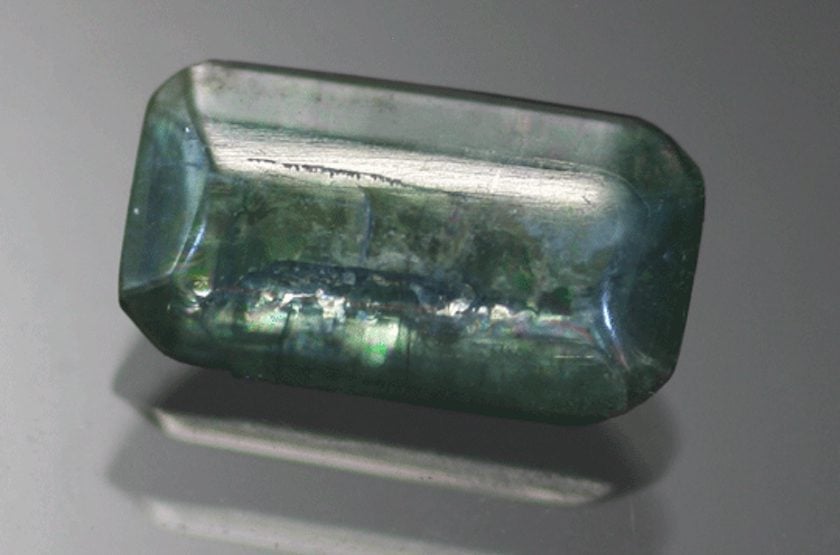Vivianite Value, Price, and Jewelry Information
Vivianite is so fragile and soft, any faceted gems would be difficult to handle safely, let alone wear. Nevertheless, its blue and green colors are so rich, a few stones (very few) have been cut.
2 Minute Read
Vivianite is so fragile and soft, any faceted gems would be difficult to handle safely, let alone wear. Nevertheless, its blue and green colors are so rich, a few stones (very few) have been cut. Vivianites make beautiful collector’s gemstones.
Start an IGS Membership today
for full access to our price guide (updated monthly).Vivianite Value
Does Vivianite Make a Good Jewelry Stone?
In an interview, rare-gem faceter and supplier C. D. Parsons acknowledges looking forward to cutting vivianite someday, something very few have done. With a hardness between talc and gypsum (1.5-2) and perfect cleavage, few could manage this feat. Thin pieces are even flexible and sectile (cuttable with a knife). Due to their fragility, vivianites would not make good jewelry stones.
However, this gem material can show beautiful dark shades of blue and green. It also displays intense pleochroism. Depending on the viewing angle, stones can reveal up to three colors, including yellowish green and olive-green, blue-green, and indigo.
When mined, vivianites are colorless or pale green, but their colors darken after exposure to light. As a result, an enthusiast may find an attractive color disappearing over time. Not surprisingly, this further de-incentivizes cutting an already challenging stone. Still, the appeal remains. You're more likely to find vivianites in mineral collections than jewelry collections.
Is There Vivianite in Odontolite?
In the past, vivianite was believed to be the cause of the blue color of so-called odontolite. This fossilized bone and teeth material may resemble turquoise. (It's also called "bone turquoise"). However, heat treatments have been shown to produce the color artificially.
Identifying Vivianite
Like its coloration, vivianite's streak starts colorless but becomes dark blue over time. Please note: don't conduct streak testing on finished gems. Test material in inconspicuous spots as a last resort only.
Bolivian material has the following properties.
- Refractive indices (RI): 1.585, 1.603, and 1.639.
- Specific gravity (SG): 2.64.
Are There Synthetic Vivianites?
Scientists have synthesized vivianite for a variety of purposes, including environmental and agricultural research. However, there's no known jewelry use for this lab-created material. There are no known gemstone treatments or enhancements.
Where are Vivianites Found?
The following sources yield good-quality gem material:
- Bolivia, Llallagua and Poopo: fine, cuttable crystals to 6 inches long.
- Cameroon, N'gaoundere: massive crystals up to 4 feet long, dark in color, cuttable.
- United States: Lemhi County, Idaho, fine crystals; Richmond, Virginia, good crystals; Bingham Canyon, Utah, crystals to 5 inches in length.
Other notable sources include the following:
- United States: California; Colorado; Delaware; Florida; Maryland; New Jersey; Black Hills, South Dakota (in pegmatites).
- Australia; Canada; England; France; Germany; Japan; Russia.
Stone Sizes
Gem cutters rarely facet vivianites, and their almost micaceous cleavage makes polishing gems very difficult. For example, the Bolivian material could yield cut stones up to 75-100 carats. However, this just doesn't occur.
Caring for Vivianites
Store your vivianite specimens out of the light to protect their color. Consult our gemstone jewelry cleaning guide for more recommendations.
Joel E. Arem, Ph.D., FGA
Dr. Joel E. Arem has more than 60 years of experience in the world of gems and minerals. After obtaining his Ph.D. in Mineralogy from Harvard University, he has published numerous books that are still among the most widely used references and guidebooks on crystals, gems and minerals in the world.
Co-founder and President of numerous organizations, Dr. Arem has enjoyed a lifelong career in mineralogy and gemology. He has been a Smithsonian scientist and Curator, a consultant to many well-known companies and institutions, and a prolific author and speaker. Although his main activities have been as a gem cutter and dealer, his focus has always been education. joelarem.com
International Gem Society
Related Articles
Black Diamond Value, Price, and Jewelry Information
Chameleon Diamond Value, Price, and Jewelry Information
Gray Diamond Value, Price, and Jewelry Information
Green Diamond Value, Price, and Jewelry Information
Latest Articles
Opal Buying Guide
Amethyst Sources Around the World: The Geological Story Behind These Purple Gemstones
Brazilianite Value, Price, and Jewelry Information
Ruby-Glass Composites vs Leaded Glass Clarity Enhancements
Never Stop Learning
When you join the IGS community, you get trusted diamond & gemstone information when you need it.
Get Gemology Insights
Get started with the International Gem Society’s free guide to gemstone identification. Join our weekly newsletter & get a free copy of the Gem ID Checklist!
